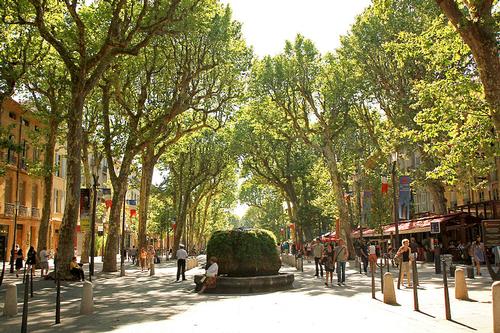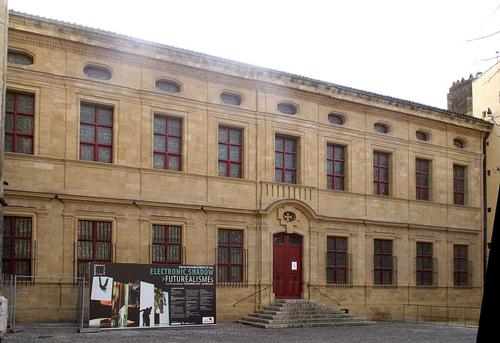FRANCE
Aix-en-Provence

Aix-en-Provence
Aix-en-Provence
Aix (French pronunciation: [eks], in medieval Occitan AICS), or Aix-en-Provence is a town in southern France, Aix is located about 30 km north of Marseille in the Provence-Alpes-Côte d'Azur region , in the department of Bouches-du-Rhône. Aix-en-Provence has approximately 143,000 inhabitants.
Location
 Aix-en Provence Square Photo: Public Domain
Aix-en Provence Square Photo: Public Domain
Aix-en-Provence is located at 43° 31 N latitude and 5° 27 E longitude on a plain overlooking the Arc, about a kilometer from the right bank of the river. Aix is located west of the Sainte-Victoire mountain.
Weather
Aix-en-Provence is located in the south of France, which gives the city a warm Mediterranean climate. The average temperature in January is 5 °C and in July it averages 24 °C. Aix has an average of 300 days of sunshine. Sometimes a cold northerly wind blows in winter. Annual rainfall is about 600 mm.
History
Aix (Aquae Sextiae) was founded in 123 BC by the Roman consul Sextius Calvinus. In 102 BC the Battle of Aquae Sextiae was fought and the Romans under Gaius Marius defeated the Teutons and the Ambrones. After the battle, the captured Germanic women committed suicide en masse, their heroism is recorded in Roman legends.
Under Diocletian, Aix-en-Provence became the main town of the province of Narbonensis Secunda at the end of the 3rd century. The Visigoths occupied Aix in 477. In the following century the city was sacked several times by the Franks and Lombards and finally occupied by the Saracens in 731 and by Charles Martel in 737.
 Map Aix-en-Provence 1575Photo: Public domain
Map Aix-en-Provence 1575Photo: Public domain
During the Middle Ages, Aix was the capital of Provence. Aix really took off in the 13th century. Under the regime of the houses of Aragon and Anjou, Aix-en-Provence grew into an artistic center and a university was founded. Aix, along with the rest of Provence, was part of France from 1487. In 1501 Louis XII established the Parliament of Provence in Aix. In the 17th and 18th centuries, Aix remained important as the administrative, educational and administrative center of Provence.
Sights
 Cours Mirabeau Aix-en-ProvencePhoto: Andrea Schaffer CC 2.0 Generic no changes made
Cours Mirabeau Aix-en-ProvencePhoto: Andrea Schaffer CC 2.0 Generic no changes made
Tourists should not miss a visit to the Cours Mirabeau. It is a wide passage, planted with double rows of plane trees and surrounded by beautiful houses and fountains. The old city wall divides the city into two parts. The new city lies to the south and west of the wall. The old town, with its wide but irregular streets and old mansions from the 16th, 17th and 18th centuries, lies to the north. Tourists often visit the Deux Garçons, the most famous brasserie in Aix. The brasserie dates back to 1792 and has had many famous visitors such as Paul Cezanne, Émile Zola and Ernest Hemingway.
 Cathedral Saint Sauveur Aix-en-ProvencePhoto: Georges Seguin CC 3.0 Unported no changes made
Cathedral Saint Sauveur Aix-en-ProvencePhoto: Georges Seguin CC 3.0 Unported no changes made
Within the medieval part of Aix you can visit the Cathedral of the Holy Savior (Cathedrale Saint Sauveur). The cathedral is built on the site of a former Roman Forum and an adjacent basilica. The cathedral has a mix of styles from the 5th to the 17th century. Includes a richly decorated Gothic-style gate with walnut doors. The interior contains tapestries from the 16th century, a 15th century triptych and a Merovingian baptistery. The dome dates back to the Renaissance and rests on original Roman columns. The Archdiocese's Palace and a Romanesque cloister are next to the cathedral.
The Hôtel de Ville (town hall) is a building in the classical style of the 17th century and located on a picturesque square (Place de l'Hôtel de Ville). It contains beautiful woodwork and some tapestries. A bell tower from 1510 adorns one side of the town hall.
South of the Cours Mirabeau is a residential area (Le Quartier Mazarin) with a number of exclusive hotels. The district was built for the nobility of Aix by the brother of Cardinal Mazarin in the last half of the 17th century. The 13th century church of Saint-Jean-de-Malte contains valuable photographs and a recently restored organ. Next to the church is the Musee Granet, dedicated to European painting and sculpture.
A Roman amphitheater has been discovered during the current archaeological excavations in Ville des Tours, a medieval suburb of Aix. In the vicinity are thermal springs, with a lot of lime and carbon dioxide. The Romans gave these sources the name Aquae Sextiae.
Aix has several museums and galleries:
Le Musee du Vieil Aix (Museum of the Old Aix), dedicated to the history and Provençal heritage of Aix.
Le Musee d'Histoire Naturelle (Natural History Museum).
Le Musee de Tapisseries (Tapestry Museum), housed in the Archbishop's Palace, and with a collection of tapestries and furniture from the 17th and 18th centuries.
Le Musee Paul Arbaud (Faience / Earthenware).
 Musee Granet Aix-en-ProvencePhoto: Malost CC 3.0 Unported no changes made
Musee Granet Aix-en-ProvencePhoto: Malost CC 3.0 Unported no changes made
Le Musee Granet, is a museum dedicated to the painting, sculpture and archeology of Aix. In June 2011, the first part of the Fondation Jean et Suzanne Planque collection was housed in the Musee Granet, with more than 180 works of art. This legacy of the Swiss painter, merchant and art collector Jean Planque, a personal friend of Pablo Picasso, has been donated to the city for an initial period of 15 years. The collection contains more than 300 works of art, including paintings and drawings by Degas, Renoir. Gauguin, Monet, Cezanne, Van Gogh, Picasso, Pierre Bonnard, Paul Klee, Fernand Leger, Giacometti and Dubuffet. The entire collection will be housed in a specially constructed annex in the Chapelle des Penitents Blancs. The museum opened in 2013.
Tips
 Quartier Mazarin Aix-en-ProvencePhoto: Georges Seguin CC 3.0 Unported no changes made
Quartier Mazarin Aix-en-ProvencePhoto: Georges Seguin CC 3.0 Unported no changes made
Aix is often referred to as the city of a thousand fountains. The 17th-century Fontaine des Quatre Dauphins (Fountain of the Four Dolphins) in the Quartier Mazarin is the most famous. There are also three beautiful fountains at the bottom of the central Cours Mirabeau. The top one is a 19th century fountain dedicated to King Rene. Halfway there is a natural hot water fountain (34 ° C) covered with moss, dating back to Roman times. At the bottom at La Rotonde is a monumental 1860 fountain with three large statues representing art, justice and agriculture. In the older part of Aix, there are also some remarkable fountains.
Useful links Aix-en-Provence
BBC Country ProfilesWorld Fact Book Explore all Countries
How to call
Last updated November 2025
Copyright: Team - The World of Info